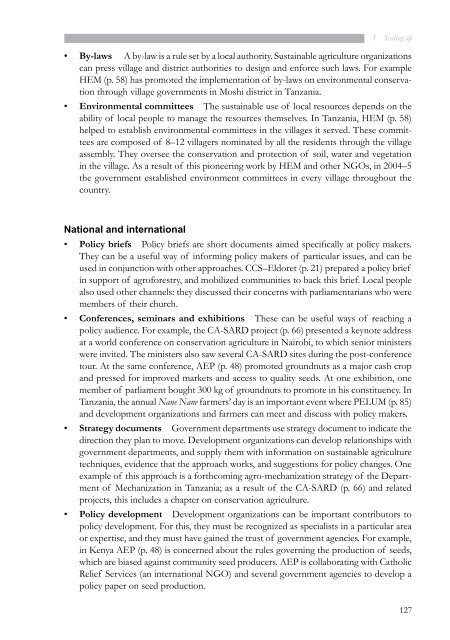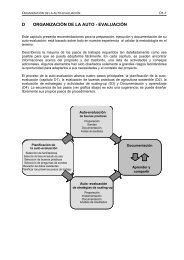cases from tanzania - Sustainet
cases from tanzania - Sustainet
cases from tanzania - Sustainet
Create successful ePaper yourself
Turn your PDF publications into a flip-book with our unique Google optimized e-Paper software.
5 Scaling up<br />
• By-laws A by-law is a rule set by a local authority. Sustainable agriculture organizations<br />
can press village and district authorities to design and enforce such laws. For example<br />
HEM (p. 58) has promoted the implementation of by-laws on environmental conservation<br />
through village governments in Moshi district in Tanzania.<br />
• Environmental committees The sustainable use of local resources depends on the<br />
ability of local people to manage the resources themselves. In Tanzania, HEM (p. 58)<br />
helped to establish environmental committees in the villages it served. These committees<br />
are composed of 8–12 villagers nominated by all the residents through the village<br />
assembly. They oversee the conservation and protection of soil, water and vegetation<br />
in the village. As a result of this pioneering work by HEM and other NGOs, in 2004–5<br />
the government established environment committees in every village throughout the<br />
country.<br />
National and international<br />
• Policy briefs Policy briefs are short documents aimed specifically at policy makers.<br />
They can be a useful way of informing policy makers of particular issues, and can be<br />
used in conjunction with other approaches. CCS–Eldoret (p. 21) prepared a policy brief<br />
in support of agroforestry, and mobilized communities to back this brief. Local people<br />
also used other channels: they discussed their concerns with parliamentarians who were<br />
members of their church.<br />
• Conferences, seminars and exhibitions These can be useful ways of reaching a<br />
policy audience. For example, the CA-SARD project (p. 66) presented a keynote address<br />
at a world conference on conservation agriculture in Nairobi, to which senior ministers<br />
were invited. The ministers also saw several CA-SARD sites during the post-conference<br />
tour. At the same conference, AEP (p. 48) promoted groundnuts as a major cash crop<br />
and pressed for improved markets and access to quality seeds. At one exhibition, one<br />
member of parliament bought 300 kg of groundnuts to promote in his constituency. In<br />
Tanzania, the annual Nane Nane farmers’ day is an important event where PELUM (p. 85)<br />
and development organizations and farmers can meet and discuss with policy makers.<br />
• Strategy documents Government departments use strategy document to indicate the<br />
direction they plan to move. Development organizations can develop relationships with<br />
government departments, and supply them with information on sustainable agriculture<br />
techniques, evidence that the approach works, and suggestions for policy changes. One<br />
example of this approach is a forthcoming agro-mechanization strategy of the Department<br />
of Mechanization in Tanzania; as a result of the CA-SARD (p. 66) and related<br />
projects, this includes a chapter on conservation agriculture.<br />
• Policy development Development organizations can be important contributors to<br />
policy development. For this, they must be recognized as specialists in a particular area<br />
or expertise, and they must have gained the trust of government agencies. For example,<br />
in Kenya AEP (p. 48) is concerned about the rules governing the production of seeds,<br />
which are biased against community seed producers. AEP is collaborating with Catholic<br />
Relief Services (an international NGO) and several government agencies to develop a<br />
policy paper on seed production.<br />
127




